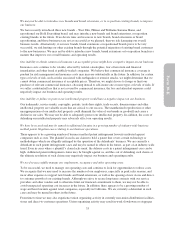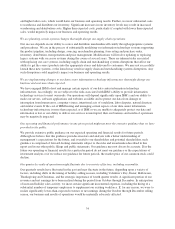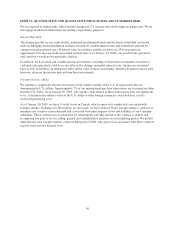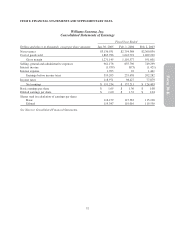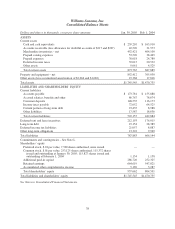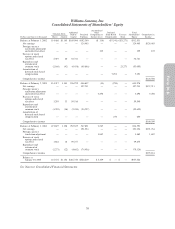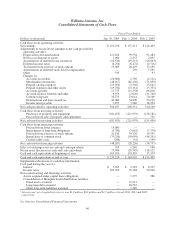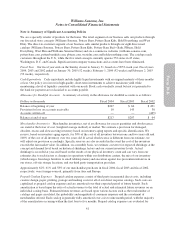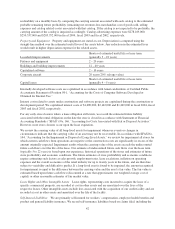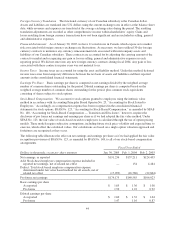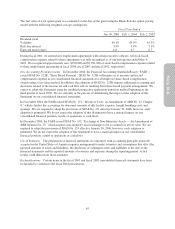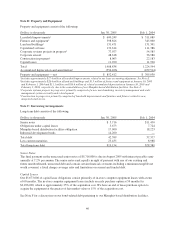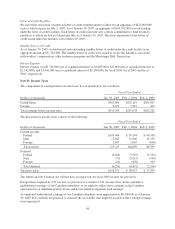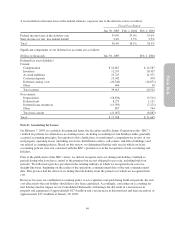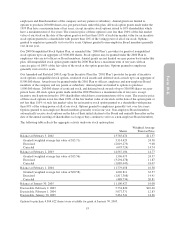Pottery Barn 2004 Annual Report Download - page 50
Download and view the complete annual report
Please find page 50 of the 2004 Pottery Barn annual report below. You can navigate through the pages in the report by either clicking on the pages listed below, or by using the keyword search tool below to find specific information within the annual report.
development of those claims, and an estimate of claims incurred but not yet reported. Factors affecting this
estimate include future inflation rates, changes in severity, benefit level changes, medical costs, and claim
settlement patterns. Should a different amount of claims occur compared to what was estimated or costs of the
claims increase or decrease beyond what was anticipated, reserves may need to be adjusted accordingly in future
periods. Our workers’ compensation liability is determined by an actuary. Reserves for self-insurance liabilities
are recorded within accrued salaries, benefits and other on our consolidated balance sheet.
Customer Deposits Customer deposits are primarily comprised of unredeemed gift certificates and merchandise
credits and deferred revenue related to undelivered merchandise. We maintain a liability for unredeemed gift
certificates and merchandise credits until the earlier of redemption, escheatment or seven years. After seven
years, the remaining unredeemed gift certificate or merchandise credit liability is relieved and recorded within
selling, general and administrative expenses.
Deferred Rent and Lease Incentives For leases that contain fixed escalations of the minimum annual lease
payment during the original term of the lease, we recognize rental expense on a straight-line basis over the lease
term, including the construction period, and record the difference between rent expense and the amount currently
payable as deferred rent. Any rental expense incurred during the construction period is capitalized as a leasehold
improvement within property and equipment and depreciated over the lease term. Deferred lease incentives
include construction allowances received from landlords, which are amortized on a straight-line basis over the
lease term, including the construction period.
Contingent Liabilities Contingent liabilities are recorded when it is determined that the outcome of an event is
expected to result in a loss that is considered probable and reasonably estimable.
Fair Value of Financial Instruments The carrying value of cash and cash equivalents, accounts receivable,
investments, accounts payable and debt approximates their estimated fair values.
Revenue Recognition We recognize revenues and the related cost of goods sold (including shipping costs) at the
time the products are received by customers in accordance with the provisions of Staff Accounting Bulletin
(“SAB”) No. 101, “Revenue Recognition in Financial Statements” as amended by SAB No. 104, “Revenue
Recognition.” Revenue is recognized for retail sales (excluding home-delivered merchandise) at the point of sale
in the store and for home-delivered merchandise and direct-to-customer sales when the merchandise is delivered
to the customer. Discounts provided to customers are accounted for as a reduction of sales. We record a reserve
for estimated product returns in each reporting period. Shipping and handling fees charged to the customer are
recognized as revenue at the time the products are delivered to the customer.
Sales Returns Reserve Our customers may return purchased items for an exchange or refund. We record a
reserve for estimated product returns, net of cost of goods sold, based on historical return trends together with
current product sales performance. If actual returns, net of cost of goods sold, are different than those projected
by management, the estimated sales returns reserve will be adjusted accordingly. A summary of activity in the
sales returns reserve is as follows:
Dollars in thousands Fiscal 2004 Fiscal 2003 Fiscal 2002
Balance at beginning of year $ 12,281 $ 10,292 $ 8,488
Provision for sales returns 215,715 182,829 163,998
Actual sales returns (214,490) (180,840) (162,194)
Balance at end of year $ 13,506 $ 12,281 $ 10,292
Vendor Allowances We may receive allowances or credits from vendors for volume rebates. In accordance with
Emerging Issues Task Force (“EITF”) 02-16, “Accounting by a Customer (Including a Reseller) for Certain
Consideration Received from a Vendor,” our accounting policy is to treat such volume rebates as an offset to the
cost of the product or services provided at the time the expense is recorded. These allowances and credits
received are primarily recorded in cost of goods sold or in selling, general and administrative expenses.
43
Form 10-K


